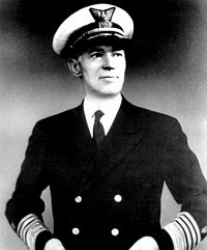
 |
|
|
||
|
Russell Randolph Waesche |
||||
|
Engagements: • World War II (1941 - 1945) |
||||
| Biography: | ||||
|
Russell Randolph Waesche Russell Randolph Waesche was born on 6 January 1886 in Thurmont, MD. He received his primary and secondary education in the Maryland public schools and then completed his freshman year at Purdue University. Coast Guard Career Waesche applied for entrance to the U.S. Revenue Cutter Service School of Instruction and was appointed a cadet on 19 May 1904. He graduated and was commissioned as an Ensign on 27 October 1906. During his first five years in the Revenue Cutter Service, Waesche was stationed in the North Atlantic, the Great Lakes, and the Pacific Northwest. He received his first command, USRC (United States Revenue Cutter) Arcata of the Pacific Northwest Division, in October 1911. He was assigned to the cutter Pamlico in November 1912 and then began a tour at United States Coast Guard (USCG) Headquarters in February 1915. He would remain in this position throughout the First World War. After the war, Waesche commanded the Eagle-class patrol boat Bothwell and the 152-foot cutter Snohomish. In 1920, Waesche was appointed U.S. Commissioner of the 3rd Division, Department of Alaska, where he was responsible for the patrol of the Bering Sea. From May 1924 through March 1926 he commanded the destroyer Beale. Afterward Waesche was assigned to the Philadelphia Navy Yard and represented the USCG at the U.S. Sesquicentennial International Exposition. He later commanded the destroyer Tucker before briefly serving as the Destroyer Force Gunnery Officer. At this point, Waesche had spent 19 years of his first 20 years of commissioned service at sea. During rum-running days, he commanded a destroyer operating out of New London, CT. In March 1928 he went to Coast Guard Headquarters as Chief Ordnance Officer for the Coast Guard. Waesche also originated the Coast Guard Institute and Correspondence School for warrant officers and enlisted personnel. He developed the plan for the reorganization of Coast Guard field forces that took place in 1932. With this experience he later served in the Navy's War Plans Division and helped develop plans to integrate the Coast Guard into the Navy in the event of war. To improve efficiency, Waesche sponsored a plan for the selection of commissioned officers. In 1935 he became an Aide to Commandant Admiral Harry G. Hamlet. (In those days, the Coast Guard was made up 12,000 men, 665 commissioned officers, and one Admiral.) His leadership abilities and competency in every assignment came to the attention of Secretary of the Treasury, Henry Morganthau, Jr. and in 1936 Commander Russell Waesche was promoted to the two-star rank of Rear Admiral (Upper Half) and appointed Commandant of the Coast Guard. As Commandant from 1936-45, Waesche successfully integrated the U.S. Lighthouse Service, a civilian agency, with the Coast Guard in 1939 as ordered by President Franklin D. Roosevelt. He also presided over the greatest expansion of the USCG in its history and ensured that the service maintained its separate identity while it was under the administrative control of the U.S. Navy. Commandant Waesche established the Coast Guard Auxiliary in 1939 and the Coast Guard Reserve in 1941. Admiral Waesche saw his small peacetime service and fleet swell to 160,000 officers and men manning over 750 cutters, 3,500 miscellaneous smaller craft, 290 Navy vessels, and 255 Army vessels. The Coast Guard participated in every major amphibious operation. Furthermore, activities at all Coast Guard air stations were increased as aviators engaged in anti-submarine and convoy escort operations and performed numerous search and rescue missions. During the war, he led 10,000 people providing security for U.S. ports and organized the Merchant Marine Council. In 1943, Waesche was promoted to Vice Admiral; in 1944 he was promoted to Admiral. (He was the first Coast Guard Commandant to achieve both those ranks.) He also secured Congressional support for the Coast Guard's return to the control of the Treasury Department as quickly as possible after the end of the Second World War. (Control of the Coast Guard was transferred back to the U.S. Treasury Department on 1 January 1946.) In doing this, the service avoided the problems that occurred after the end of the First World War when the Navy attempted to maintain its control of the USCG. Waesche earned praise from the Secretary of the Navy for his stewardship of the Coast Guard during World War II. After the longest tenure as USCG Commandant, 12 years (three 4-year terms), Admiral Waesche retired on 1 January 1946, due to ill health. His tenure as Commandant was one of the most successful in the U.S. Coast Guard's distinguished history. Honors • In 1944, he was elected President of the Society of American Military Engineers. • In March 1946, he was appointed to the "Elder Statesman's Council for National Defense" by President Harry S. Truman. Death and Burial Admiral Russell Randolph Waesche died on 17 October 1946. He is buried at Arlington National Cemetery in Arlington, VA, in Section 8. He was survived by his second wife, Agnes R. Waesche. She died on 3 November 1947 and is buried with him. |
||||
| Honoree ID: 877 | Created by: MHOH | |||
Ribbons
Medals
Badges
Honoree Photos
 |  |  |
 |  |
 |


